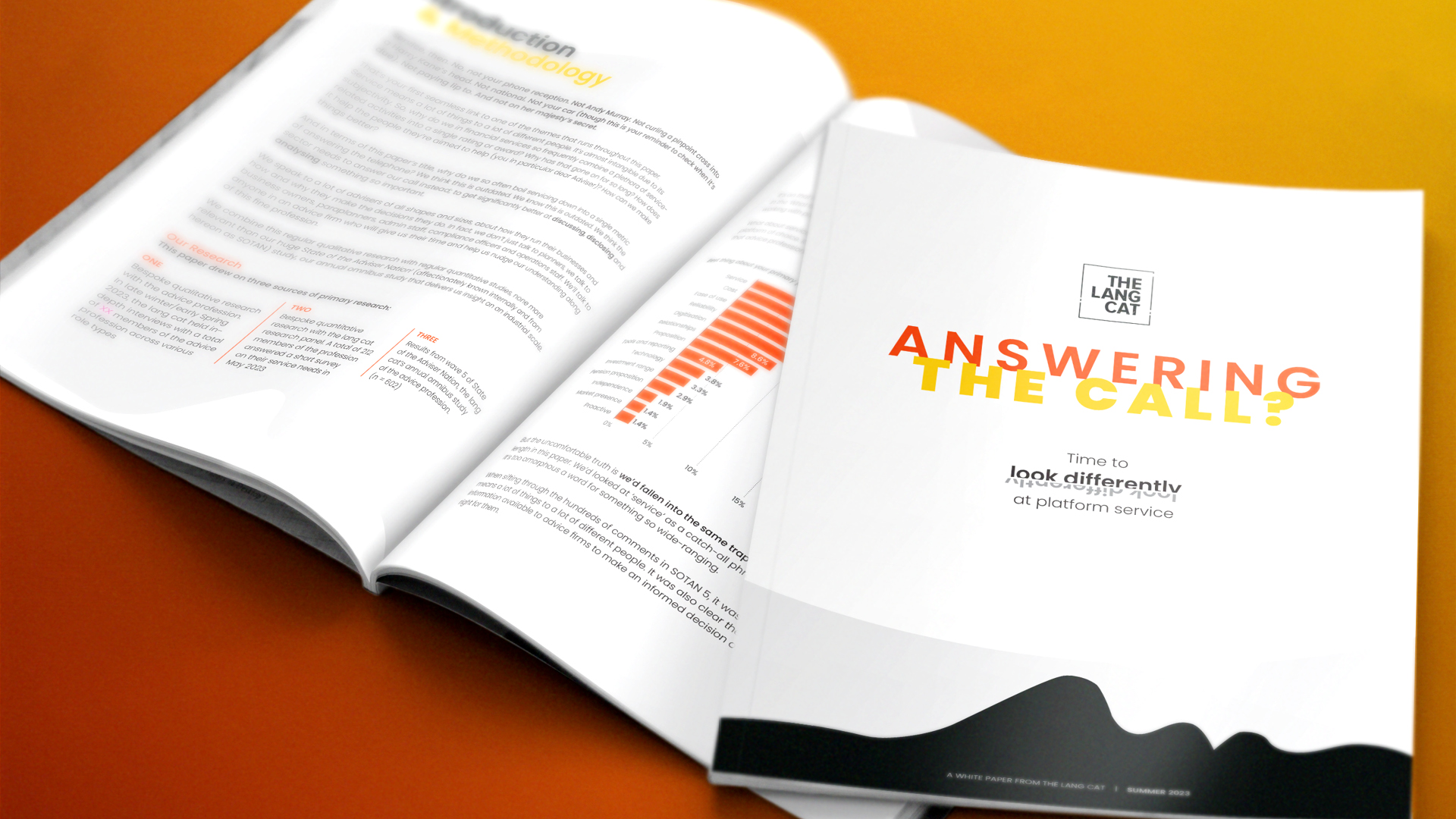So this is an unusual blog for us. I’m very conscious that quite a lot of real people, as opposed to financial industry apparatchiks, are going to read this given the nature of the subject. I’m afraid I’m going to have to be a bore and outline a couple of things up front.
First, we’re not financial advisers. We’re completely unregulated, which is why I still have hair, and as such we can’t tell anyone what to do with their personal finances, nor would we ever try to. We’re massive supporters of professional financial advice, and if you’re a member of the public reading this and unsure what to do, then go get advice. If you don’t have an adviser you could try here or here.
Secondly, if you’re here I’m assuming you know a little about investment platforms and how charges work. So I won’t explain basic terms as I go, but will link out to definitions where appropriate.
Thirdly, all this is independent analysis. We work with lots of platforms on a regular basis, but this analysis is just us and we aren’t being paid to produce it by anyone; we have no axe to grind.
If that’s all tickety-boo, then pull up a chair and let’s crack on.
So, then, Hargreaves Lansdown. Has a pricing announcement by a direct investment platform ever been so eagerly awaited? I don’t know, and neither do you. But what you do know, or at least will in a few minutes’ time, is what HL expects you to pony up for holding assets on its Vantage service.
HL is launching its offer into a funny old market. Direct platforms have until April to stop living off rebates from fund managers (in respect of new business, anyway). Of the top platforms by market share, at least half have still to announce their pricing, and we include Barclays Stockbrokers and Fidelity in that. Time to get a move on, girls. For the record, we’ll only do comparisons here with those who have unveiled their explicit pricing.
Back to HL. It announced its pricing in a stock exchange missive at 7am today, when I was just in the showers at Euston, which was inconsiderate. That said, everything else was pretty good news.
So you pay 0.45% on your funds up to £250k, 0.25% on the rest up to £1m, 0.1% on the next £1m and what my granny used to call ‘hee haw’ on the amount above ‘£2m.
First thoughts. well done HL. Analysts (from Barclays, why would they have an axe to grind?) had placed the charging at c. 0.6% or 60 basis points tiering down or 0.5% plus dealing charges. This obviously beats those predictions, and the Bristolian buddies will be stifling giggles on that, I suspect.
Recent press reports put the average SIPP on HL’s Vantage service at £47k, the average ISA just under £30k and something like 57% of its clients have less than £50k. I don’t have a figure on the percentage of those with less than £250k, but I’ll bet it’s the overwhelming, crushing majority of clients. So unless you’re a very tubby cat, you’re paying 0.45% from now on.
There are no dealing charges on mutual funds, and no wrapper fees. So whereas on most direct platforms you’ll pay an additional whack on top of your percentage charge, HL are happy just to stick with what’s there. SIPPs don’t cost much more to run than ISAs, so I like that. Tick.
A further tick for capping charges at £2m. There comes a point where you’ve made enough money, and not enough platforms recognise this. In ‘£££ terms this is £4,000 on a £2m fund, which is A LOT, but still the principle is good.
IT’S GOOD TO COMPARE
Many platforms in the direct space have some element of fixed charge, and a couple (Interactive Investor and Alliance Trust Savings) only operate on a fixed charge basis. You’ll see the impact of this in the tables below. Broadly speaking, you’re better off in HL’s model (on a charges basis anyway) for smaller pots, but the fee-only models start to kick in at/around £50k (as does the hybrid model run by AJ Bell YouInvest, for example).
Here are our comparative tables. If you haven’t read them before, we take everyone’s charges, squish them down using various assumptions and then re-express them on a common basis, first as a percentage of your investment, then in pound terms. We make no assumptions on term (how long you hold your investment) and ignore set-up fees, so think of this as year 2 on. HL doesn’t have any set-up fees, as it happens.
For trading assumptions, we’ve worked on a 10-fund portfolio, of which 5 funds turn over each year. That’s 5 buys and 5 sells, making 10 trades. This matters for guys like The Share Centre (1% of your trade each time) or ATS (£12.50 a shot), but doesn’t matter for someone like HL or Charles Stanley, who have no trading charges. We might have overstated how often people trade, which would skew these figures. We will publish more detailed stuff in a couple of weeks (when others have shown their hand) and include high/medium/low trading frequencies so you can get a better picture.
You’ll see red/amber/green colouring – these are relative heatmaps. What that means is that the price leader at each portfolio size will be green, with the worst outlier (most expensive) being red. Those inbetween will shade from green through to amber and then red. It does NOT NOT NOT mean that it is red compared to some arbitrary amount we’ve made up.
CONCLUSIONS
So, what does all this mean? Should you start switching off? The answer is, of course, it depends. If you’re using HL’s best friends funds club (or whatever they call it these days) then you might find the overall cost of investing is more competitive than these tables suggest. HL has got some funds down to 0.65% instead of a standard 0.75%, and some others (presumably where they have compromising photos of the fund manager) down to an average of 0.54%. That’s quite a deep discount. We don’t have details of those funds yet, but as we do we’ll publish what we find out.
You should look at the Total Cost of Ownership of funds rather than just platform price. However, HL only gets an advantage here if, if you’re happy to be constrained in your investment choice. Investing in an active fund cos it’s cheap probably isn’t a recipe for riches (bear in mind that passive funds like those from Vanguard won’t have discounts normally). Careful analysis is needed here of your own situation, again, get advice if you’re unsure.
It’s normally at this point that folk start banging on about price v value, and I have to invoke the Angry Value Pixie. You get to decide what value HL adds, it doesn’t. I do think HL has very good service (I’m a customer) and that might command a premium. It’s all a matter of how much that premium should be. You can pretty much halve your charges by shopping elsewhere for your platform needs. If you’re going to use HL’s cheapo funds, that differential won’t be so big in the real world – then again, if you hardly ever trade, the differential might be bigger.
Generally speaking, though, you can look at Charles Stanley, AJ Bell YouInvest, ATS or Interactive depending on how well-upholstered you are and how frequently you trade, and you might do a bit better.
Finally, HL reckons this will cost them £17m and they’ll make it back easily with additional AUA. As I write, the stock market doesn’t agree and has treated it much as Little Bunny Foo Foo does with fieldmice and bopped it on the head to the tune of 2.6% or 41p. That still leaves it with about the same market cap as M&S.
The overall lang cat verdict, a solid performance from HL, and probably enough to avoid big outflows. It’s up to the others with sharper pricing now to make their case and bring it to the big bad boys from Bristol.
If we get anything interesting throughout the day we’ll publish another blog. Leave your comments below, HL guys read this stuff, so you never know, you might get a reply.




